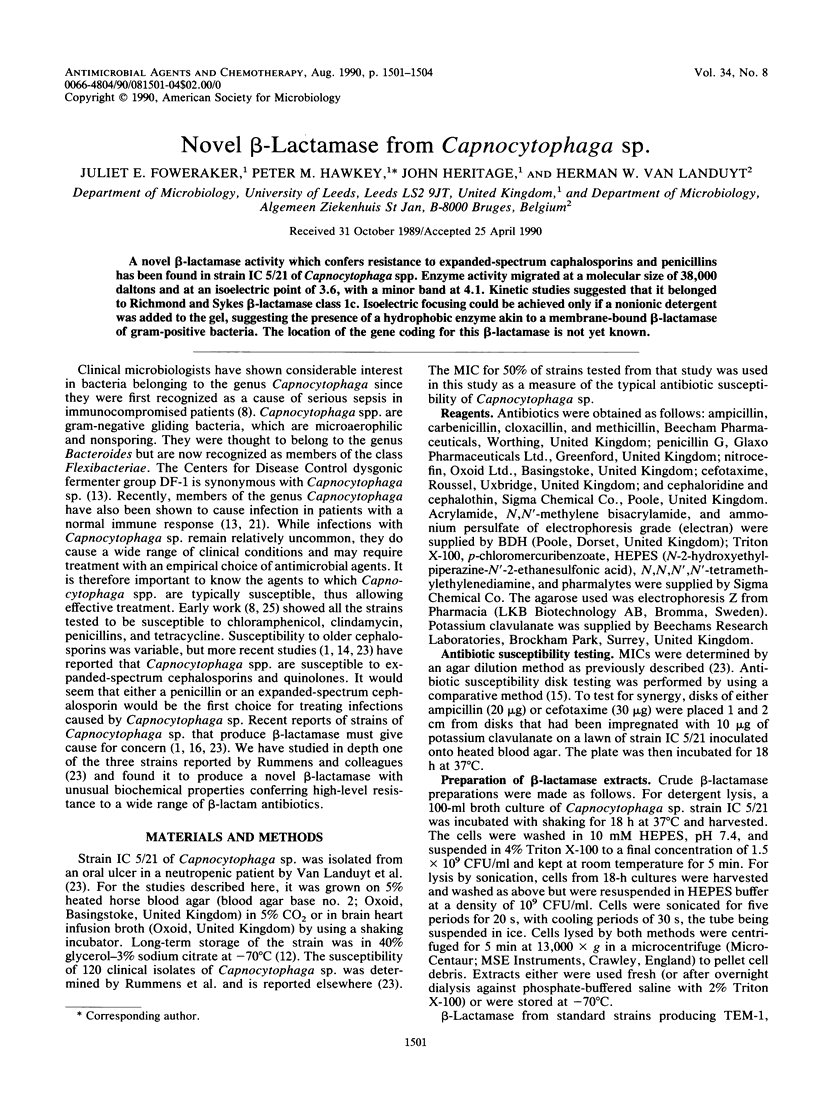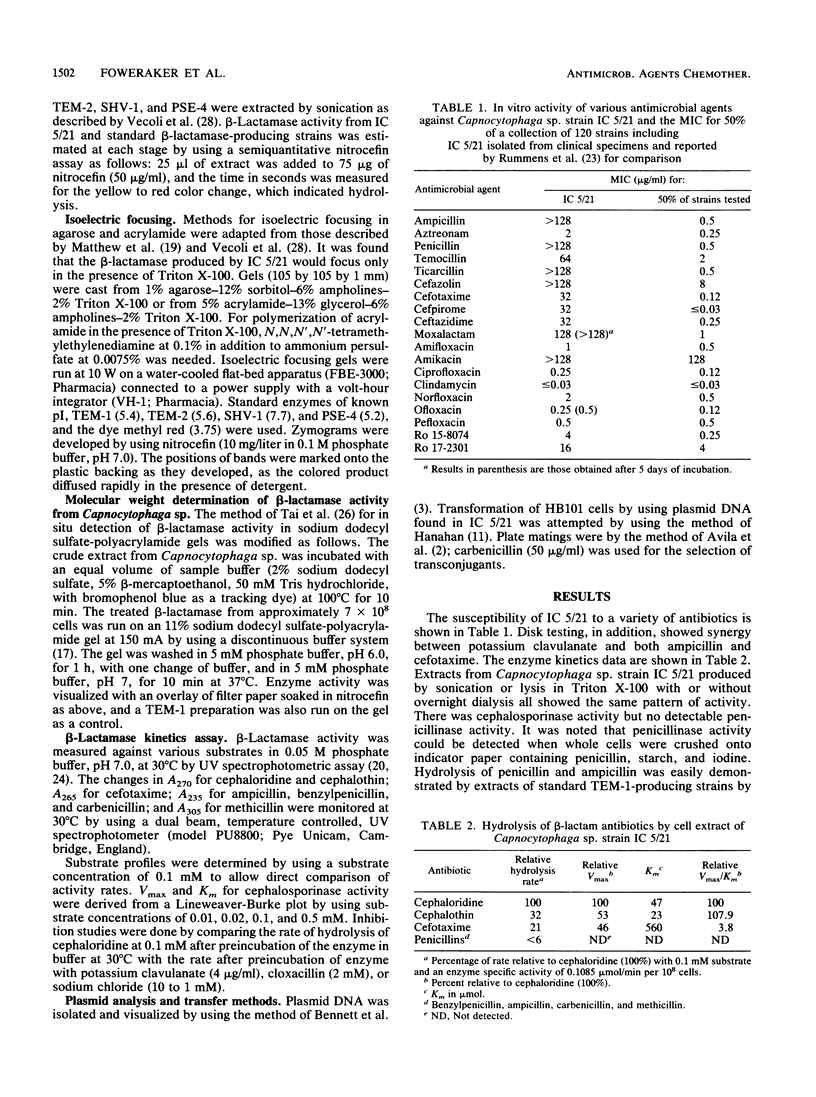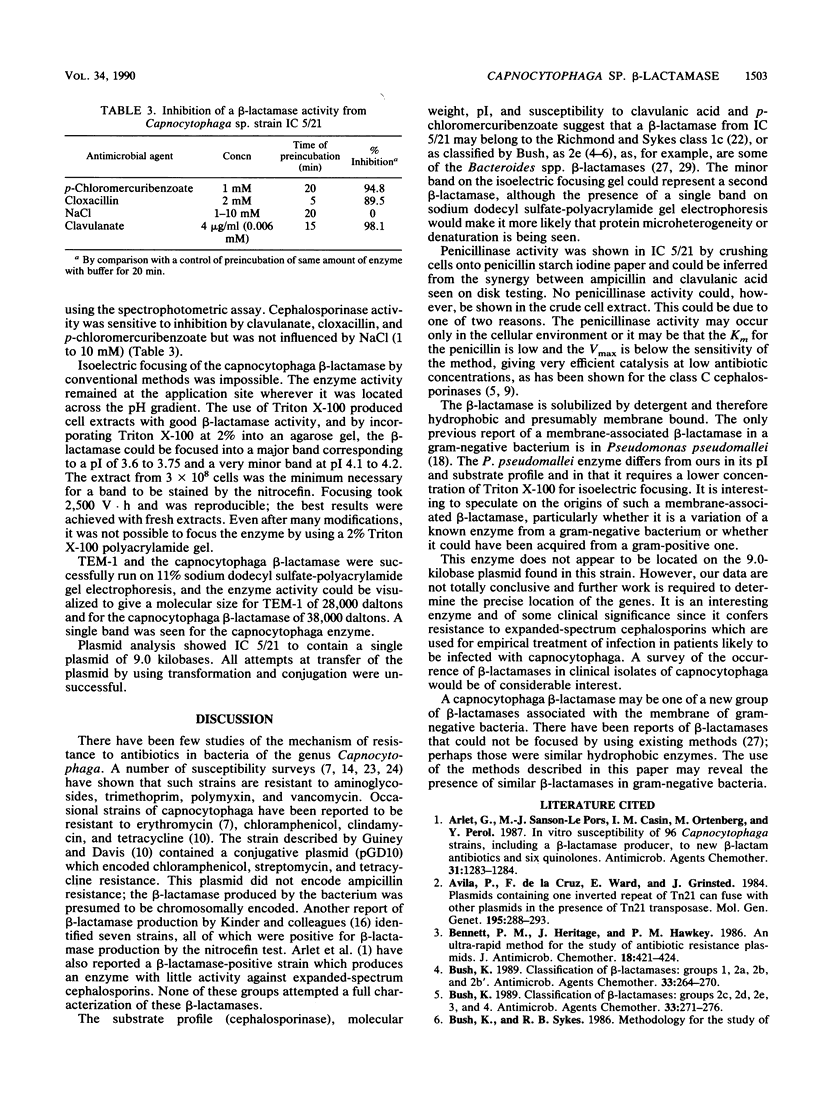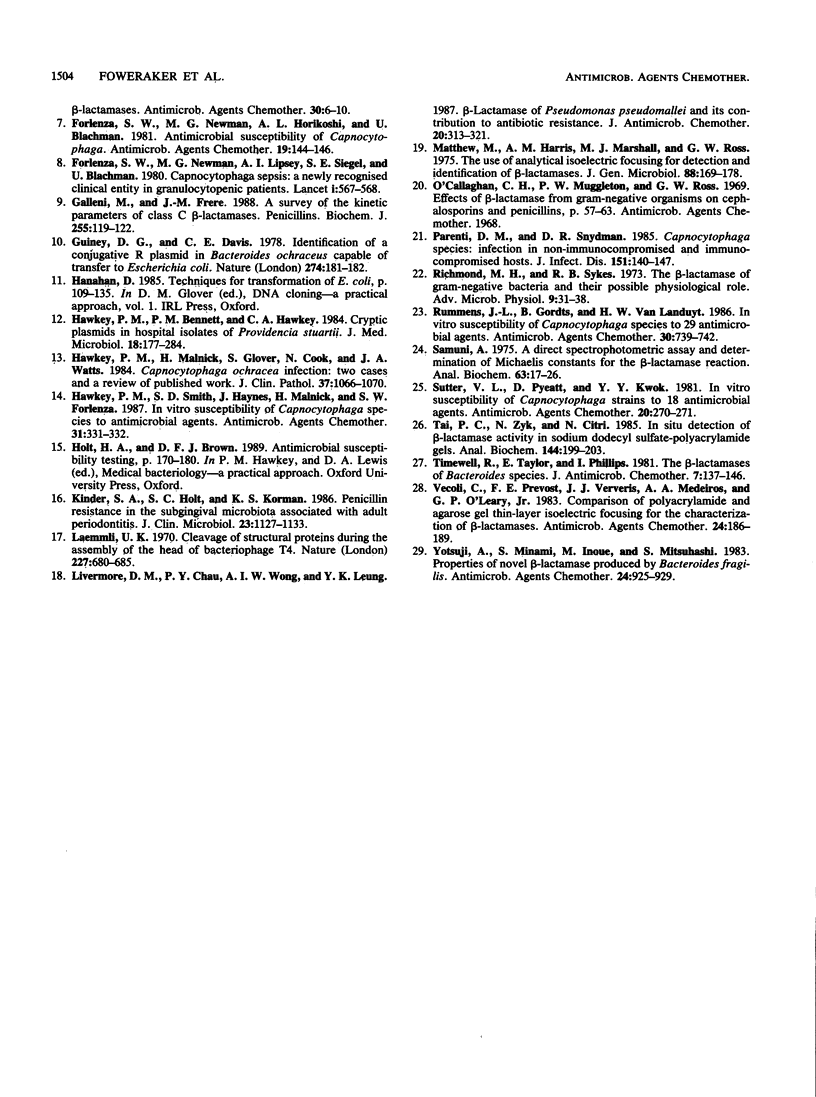Abstract
A novel beta-lactamase activity which confers resistance to expanded-spectrum cephalosporins and penicillins has been found in strain IC 5/21 of Capnocytophaga spp. Enzyme activity migrated at a molecular size of 38,000 daltons and at an isoelectric point of 3.6, with a minor band at 4.1. Kinetic studies suggested that it belonged to Richmond and Sykes beta-lactamase class 1c. Isoelectric focusing could be achieved only if a nonionic detergent was added to the gel, suggesting the presence of a hydrophobic enzyme akin to a membrane-bound beta-lactamase of gram-positive bacteria. The location of the gene coding for this beta-lactamase is not yet known.
Full text
PDF



Selected References
These references are in PubMed. This may not be the complete list of references from this article.
- Arlet G., Sanson-Le Pors M. J., Casin I. M., Ortenberg M., Perol Y. In vitro susceptibility of 96 Capnocytophaga strains, including a beta-lactamase producer, to new beta-lactam antibiotics and six quinolones. Antimicrob Agents Chemother. 1987 Aug;31(8):1283–1284. doi: 10.1128/aac.31.8.1283. [DOI] [PMC free article] [PubMed] [Google Scholar]
- Avila P., de la Cruz F., Ward E., Grinsted J. Plasmids containing one inverted repeat of Tn21 can fuse with other plasmids in the presence of Tn21 transposase. Mol Gen Genet. 1984;195(1-2):288–293. doi: 10.1007/BF00332761. [DOI] [PubMed] [Google Scholar]
- Bennett P. M., Heritage J., Hawkey P. M. An ultra-rapid method for the study of antibiotic resistance plasmids. J Antimicrob Chemother. 1986 Sep;18(3):421–424. doi: 10.1093/jac/18.3.421. [DOI] [PubMed] [Google Scholar]
- Bush K. Classification of beta-lactamases: groups 1, 2a, 2b, and 2b'. Antimicrob Agents Chemother. 1989 Mar;33(3):264–270. doi: 10.1128/aac.33.3.264. [DOI] [PMC free article] [PubMed] [Google Scholar]
- Bush K. Classification of beta-lactamases: groups 2c, 2d, 2e, 3, and 4. Antimicrob Agents Chemother. 1989 Mar;33(3):271–276. doi: 10.1128/aac.33.3.271. [DOI] [PMC free article] [PubMed] [Google Scholar]
- Forlenza S. W., Newman M. G., Horikoshi A. L., Blachman U. Antimicrobial susceptibility of Capnocytophaga. Antimicrob Agents Chemother. 1981 Jan;19(1):144–146. doi: 10.1128/aac.19.1.144. [DOI] [PMC free article] [PubMed] [Google Scholar]
- Forlenza S. W., Newman M. G., Lipsey A. I., Siegel S. E., Blachman U. Capnocytophaga sepsis: a newly recognised clinical entity in granulocytopenic patients. Lancet. 1980 Mar 15;1(8168 Pt 1):567–568. doi: 10.1016/s0140-6736(80)91057-0. [DOI] [PubMed] [Google Scholar]
- Galleni M., Frère J. M. A survey of the kinetic parameters of class C beta-lactamases. Penicillins. Biochem J. 1988 Oct 1;255(1):119–122. doi: 10.1042/bj2550119. [DOI] [PMC free article] [PubMed] [Google Scholar]
- Guiney D. G., Jr, Davis C. E. Identification of a conjugative R plasmid in Bacteroides ochraceus capable of transfer to Escherichia coli. Nature. 1978 Jul 13;274(5667):181–182. doi: 10.1038/274181a0. [DOI] [PubMed] [Google Scholar]
- Hawkey P. M., Bennett P. M., Hawkey C. A. Cryptic plasmids in hospital isolates of Providencia stuarti. J Med Microbiol. 1984 Oct;18(2):277–284. doi: 10.1099/00222615-18-2-277. [DOI] [PubMed] [Google Scholar]
- Hawkey P. M., Malnick H., Glover S. A., Cook N., Watts J. A. Capnocytophaga ochracea infection: two cases and a review of the published work. J Clin Pathol. 1984 Sep;37(9):1066–1070. doi: 10.1136/jcp.37.9.1066. [DOI] [PMC free article] [PubMed] [Google Scholar]
- Hawkey P. M., Smith S. D., Haynes J., Malnick H., Forlenza S. W. In vitro susceptibility of Capnocytophaga species to antimicrobial agents. Antimicrob Agents Chemother. 1987 Feb;31(2):331–332. doi: 10.1128/aac.31.2.331. [DOI] [PMC free article] [PubMed] [Google Scholar]
- Kinder S. A., Holt S. C., Korman K. S. Penicillin resistance in the subgingival microbiota associated with adult periodontitis. J Clin Microbiol. 1986 Jun;23(6):1127–1133. doi: 10.1128/jcm.23.6.1127-1133.1986. [DOI] [PMC free article] [PubMed] [Google Scholar]
- Laemmli U. K. Cleavage of structural proteins during the assembly of the head of bacteriophage T4. Nature. 1970 Aug 15;227(5259):680–685. doi: 10.1038/227680a0. [DOI] [PubMed] [Google Scholar]
- Livermore D. M., Chau P. Y., Wong A. I., Leung Y. K. beta-Lactamase of Pseudomonas pseudomallei and its contribution to antibiotic resistance. J Antimicrob Chemother. 1987 Sep;20(3):313–321. doi: 10.1093/jac/20.3.313. [DOI] [PubMed] [Google Scholar]
- Mathew A., Harris A. M., Marshall M. J., Ross G. W. The use of analytical isoelectric focusing for detection and identification of beta-lactamases. J Gen Microbiol. 1975 May;88(1):169–178. doi: 10.1099/00221287-88-1-169. [DOI] [PubMed] [Google Scholar]
- Parenti D. M., Snydman D. R. Capnocytophaga species: infections in nonimmunocompromised and immunocompromised hosts. J Infect Dis. 1985 Jan;151(1):140–147. doi: 10.1093/infdis/151.1.140. [DOI] [PubMed] [Google Scholar]
- Richmond M. H., Sykes R. B. The beta-lactamases of gram-negative bacteria and their possible physiological role. Adv Microb Physiol. 1973;9:31–88. doi: 10.1016/s0065-2911(08)60376-8. [DOI] [PubMed] [Google Scholar]
- Rummens J. L., Gordts B., Van Landuyt H. W. In vitro susceptibility of Capnocytophaga species to 29 antimicrobial agents. Antimicrob Agents Chemother. 1986 Nov;30(5):739–742. doi: 10.1128/aac.30.5.739. [DOI] [PMC free article] [PubMed] [Google Scholar]
- Samuni A. A direct spectrophotometric assay and determination of Michaelis constants for the beta-lactamase reaction. Anal Biochem. 1975 Jan;63(1):17–26. doi: 10.1016/0003-2697(75)90185-2. [DOI] [PubMed] [Google Scholar]
- Sutter V. L., Pyeatt D., Kwok Y. Y. In vitro susceptibility of Capnocytophaga strains to 18 antimicrobial agents. Antimicrob Agents Chemother. 1981 Aug;20(2):270–271. doi: 10.1128/aac.20.2.270. [DOI] [PMC free article] [PubMed] [Google Scholar]
- Tai P. C., Zyk N., Citri N. In situ detection of beta-lactamase activity in sodium dodecyl sulfate-polyacrylamide gels. Anal Biochem. 1985 Jan;144(1):199–203. doi: 10.1016/0003-2697(85)90105-8. [DOI] [PubMed] [Google Scholar]
- Timewell R., Taylor E., Phillips I. The beta-lactamases of Bacteroides species. J Antimicrob Chemother. 1981 Feb;7(2):137–146. doi: 10.1093/jac/7.2.137. [DOI] [PubMed] [Google Scholar]
- Vecoli C., Prevost F. E., Ververis J. J., Medeiros A. A., O'Leary G. P., Jr Comparison of polyacrylamide and agarose gel thin-layer isoelectric focusing for the characterization of beta-lactamases. Antimicrob Agents Chemother. 1983 Aug;24(2):186–189. doi: 10.1128/aac.24.2.186. [DOI] [PMC free article] [PubMed] [Google Scholar]
- Yotsuji A., Minami S., Inoue M., Mitsuhashi S. Properties of novel beta-lactamase produced by Bacteroides fragilis. Antimicrob Agents Chemother. 1983 Dec;24(6):925–929. doi: 10.1128/aac.24.6.925. [DOI] [PMC free article] [PubMed] [Google Scholar]


